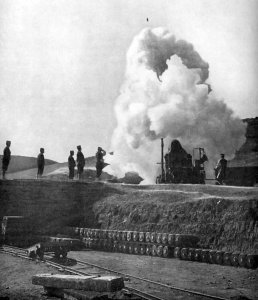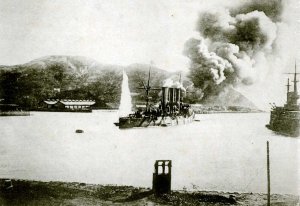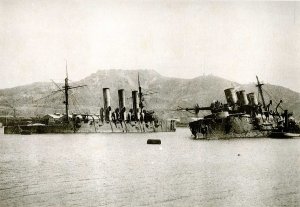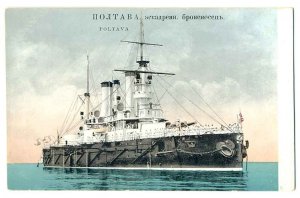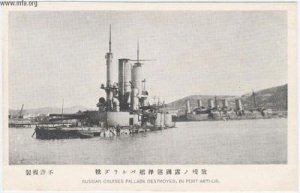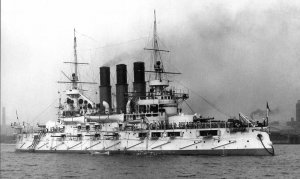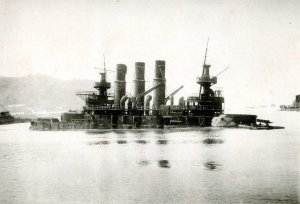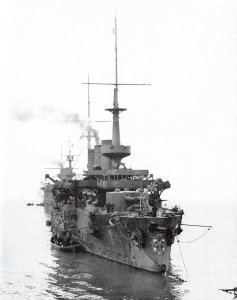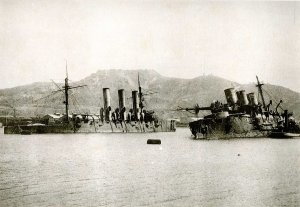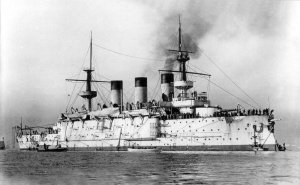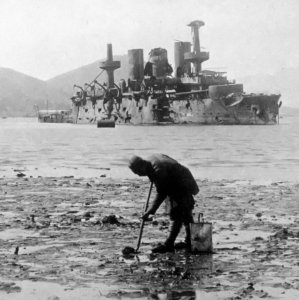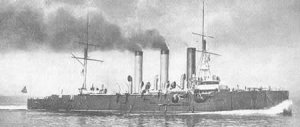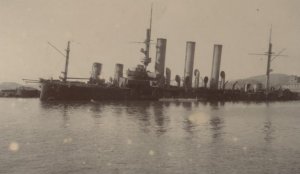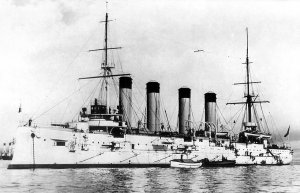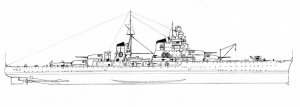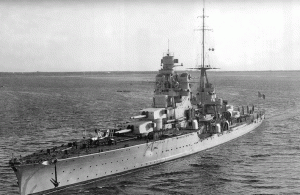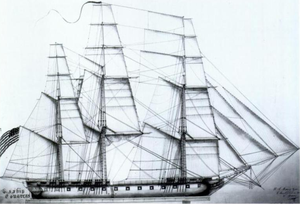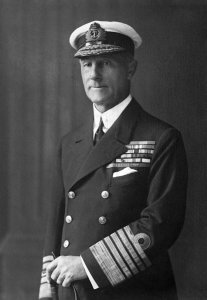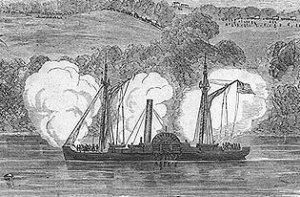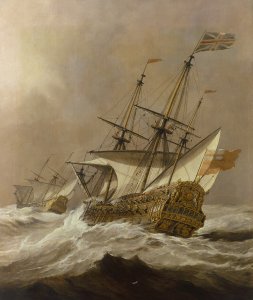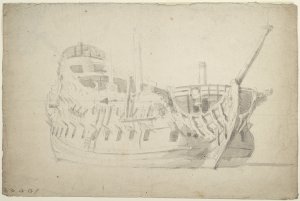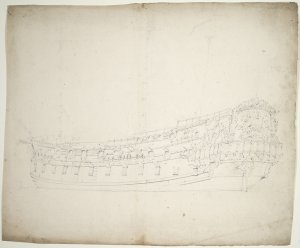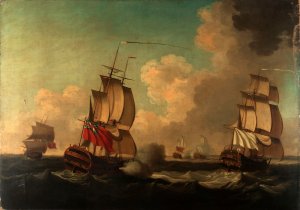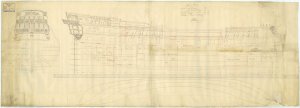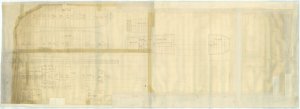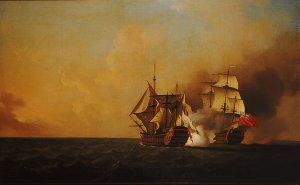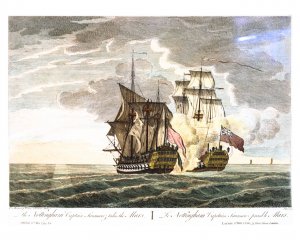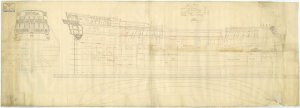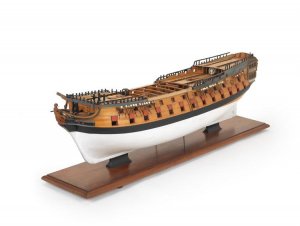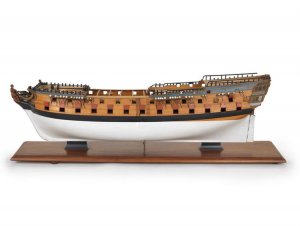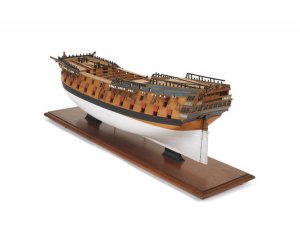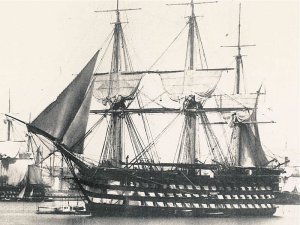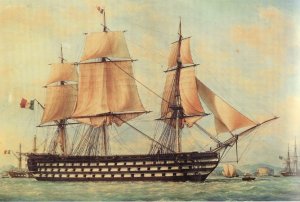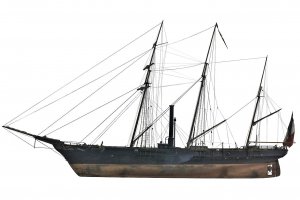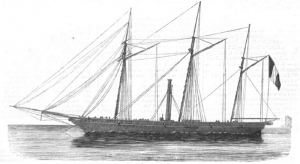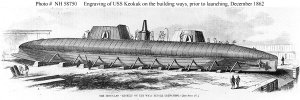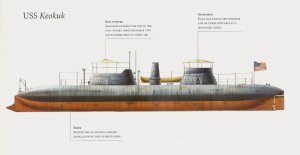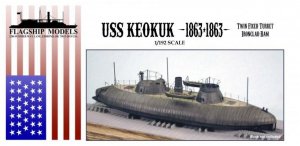Today in Naval History - Naval / Maritime Events in History
5 December 1797 - Launch of Hercule, a Téméraire class ship of the line of the French Navy
HMS Hercule was a 74-gun third rate ship of the line of the Royal Navy. She was previously Hercule, a Téméraire class ship of the line of the French Navy, but was captured on her maiden voyage in 1798, and spent the rest of her career as a British ship. She was broken up in 1810

HMS Hercules, a detail of a larger canvas: Combat de la Poursuivante contre l'Hercule, 1803 ("Fight of the Poursuivante against the Hercules", 1803). Which shows the French frigate Poursuivante raking the British ship HMS Hercules, in the action of 28 June 1803.
Class and type: Téméraire-class ship of the line
Tonnage: 1876 bm
Displacement:
Beam: 14.90 metres (48 ft 11 in)
Draught: 7.26 metres (23.8 ft) (22 pied)
Propulsion: Up to 2,485 m2 (26,750 sq ft) of sails
Armament:
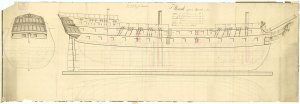
Scale: 1:48. Plan showing the body plan with stern board decoration, sheer lines with inboard detail and figurehead, and longitudinal hafl-breadth for 'Hercule' (1798), a captured French Third Rate, as fitted at Plymouth Dockyard as a 74-gun Third Rate, two-decker in 1801. Signed by John Marshall [Master Shipwright, Plymouth Dockyard, 1795-1801].
French career and capture
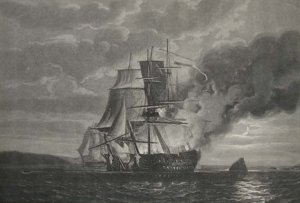
Combat between Hercule and Mars. The English frigate HMS Juno can be distinguished in the background.
During her maiden journey, on 21 April 1798, and just 24 hours out of port, she was captured by the British ship HMS Mars after a violent fight at the Battle of the Raz de Sein, off Île de Sein near Brest. Hercule attempted to escape through the Passage du Raz, but the tide was running in the wrong direction, and she was forced to anchor, giving the British the chance to attack at close quarters. The two ships were of equal force, both seventy-fours, but Hercule was newly commissioned; after more than an hour and a half of bloody fighting at close quarters she struck her colours at 10.30 pm, having lost — by her own officers' estimate — 290 men killed and wounded. On Mars 31 men were killed, including her captain, Alexander Hood, and 60 wounded. Captain Louis Lhéritier of Hercule was wounded by sabre and spike leading his boarding party.
The Hercule was recommissioned in the Royal Navy as HMS Hercule.

The ‘Mars’ (right) shown engaging the ‘Hercule’ (left) surrounded by areas of land. Both are shown in starboard quarter view. The sails of the ‘Mars’ have been shot through. Coloured engraving. Publisher’s address at bottom.
British career
In mid-1803, the squadron under Captain Henry William Bayntun, consisting of Cumberland, Hercule, Bellerophon, Elephant, and Vanguard captured Poisson Volant and Superieure. The Royal Navy took both into service.
In May 1803, Hercule's captain Solomon Ferris died suddenly on board the ship.
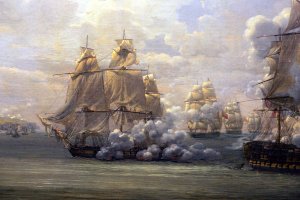
Detail from the Fight of the Poursuivante against the British ship Hercules, 28 June 1803: Poursuivante delivers her decisive raking broadside. Louis-Philippe Crépin, 1819, Musée national de la Marine
Main article: Action of 28 June 1803
On 28 June 1803, during the Blockade of Saint-Domingue, Hercule was under the command of First Lieutenant John B. Hills, who was acting captain because Captain Ferris had died the previous month. She encountered the French frigate Poursuivante and the corvette Mignonne, and Hercule attempted to capture Poursuivante. However, Poursuivante outmaneuvered Hercule and delivered raking fire. Hercule (Louis-Philippe Crépin immortalised the incident in a painting.) HMS Goliaththen captured Mignonne.
Hercule, under Captain Dun, participated in the failed attempt in January 1804 to capture Curaçao
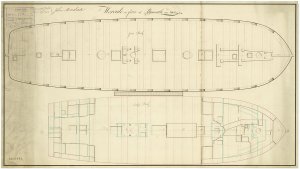
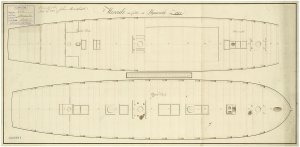
https://threedecks.org/index.php?display_type=show_ship&id=2080
https://en.wikipedia.org/wiki/HMS_Hercule_(1798)
http://collections.rmg.co.uk/collec...el-318536;browseBy=vessel;vesselFacetLetter=H
https://en.wikipedia.org/wiki/Action_of_28_June_1803
5 December 1797 - Launch of Hercule, a Téméraire class ship of the line of the French Navy
HMS Hercule was a 74-gun third rate ship of the line of the Royal Navy. She was previously Hercule, a Téméraire class ship of the line of the French Navy, but was captured on her maiden voyage in 1798, and spent the rest of her career as a British ship. She was broken up in 1810

HMS Hercules, a detail of a larger canvas: Combat de la Poursuivante contre l'Hercule, 1803 ("Fight of the Poursuivante against the Hercules", 1803). Which shows the French frigate Poursuivante raking the British ship HMS Hercules, in the action of 28 June 1803.
Class and type: Téméraire-class ship of the line
Tonnage: 1876 bm
Displacement:
- 2,966 tonnes
- 5,260 tonnes fully loaded
Beam: 14.90 metres (48 ft 11 in)
Draught: 7.26 metres (23.8 ft) (22 pied)
Propulsion: Up to 2,485 m2 (26,750 sq ft) of sails
Armament:
- 74 guns:
- Lower gundeck: 28 × 36-pounder long guns
- Upper gundeck: 30 × 18-pounder long guns
- Forecastle and Quarter deck:
- 16 × 8-pounder long guns
- 4 × 36-pdr carronades

Scale: 1:48. Plan showing the body plan with stern board decoration, sheer lines with inboard detail and figurehead, and longitudinal hafl-breadth for 'Hercule' (1798), a captured French Third Rate, as fitted at Plymouth Dockyard as a 74-gun Third Rate, two-decker in 1801. Signed by John Marshall [Master Shipwright, Plymouth Dockyard, 1795-1801].
French career and capture

Combat between Hercule and Mars. The English frigate HMS Juno can be distinguished in the background.
During her maiden journey, on 21 April 1798, and just 24 hours out of port, she was captured by the British ship HMS Mars after a violent fight at the Battle of the Raz de Sein, off Île de Sein near Brest. Hercule attempted to escape through the Passage du Raz, but the tide was running in the wrong direction, and she was forced to anchor, giving the British the chance to attack at close quarters. The two ships were of equal force, both seventy-fours, but Hercule was newly commissioned; after more than an hour and a half of bloody fighting at close quarters she struck her colours at 10.30 pm, having lost — by her own officers' estimate — 290 men killed and wounded. On Mars 31 men were killed, including her captain, Alexander Hood, and 60 wounded. Captain Louis Lhéritier of Hercule was wounded by sabre and spike leading his boarding party.
The Hercule was recommissioned in the Royal Navy as HMS Hercule.

The ‘Mars’ (right) shown engaging the ‘Hercule’ (left) surrounded by areas of land. Both are shown in starboard quarter view. The sails of the ‘Mars’ have been shot through. Coloured engraving. Publisher’s address at bottom.
British career
In mid-1803, the squadron under Captain Henry William Bayntun, consisting of Cumberland, Hercule, Bellerophon, Elephant, and Vanguard captured Poisson Volant and Superieure. The Royal Navy took both into service.
In May 1803, Hercule's captain Solomon Ferris died suddenly on board the ship.

Detail from the Fight of the Poursuivante against the British ship Hercules, 28 June 1803: Poursuivante delivers her decisive raking broadside. Louis-Philippe Crépin, 1819, Musée national de la Marine
Main article: Action of 28 June 1803
On 28 June 1803, during the Blockade of Saint-Domingue, Hercule was under the command of First Lieutenant John B. Hills, who was acting captain because Captain Ferris had died the previous month. She encountered the French frigate Poursuivante and the corvette Mignonne, and Hercule attempted to capture Poursuivante. However, Poursuivante outmaneuvered Hercule and delivered raking fire. Hercule (Louis-Philippe Crépin immortalised the incident in a painting.) HMS Goliaththen captured Mignonne.
Hercule, under Captain Dun, participated in the failed attempt in January 1804 to capture Curaçao


https://threedecks.org/index.php?display_type=show_ship&id=2080
https://en.wikipedia.org/wiki/HMS_Hercule_(1798)
http://collections.rmg.co.uk/collec...el-318536;browseBy=vessel;vesselFacetLetter=H
https://en.wikipedia.org/wiki/Action_of_28_June_1803



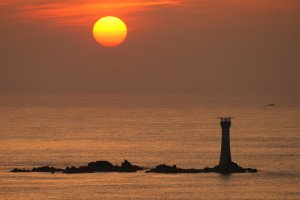

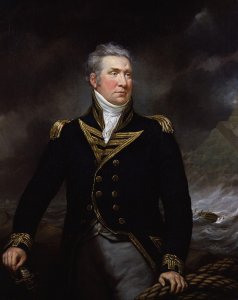
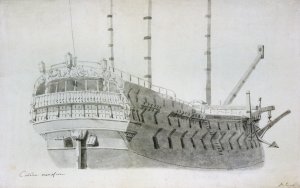
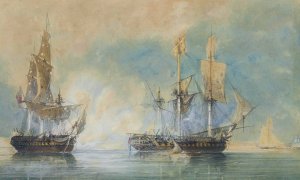
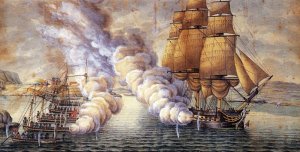
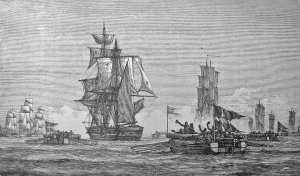
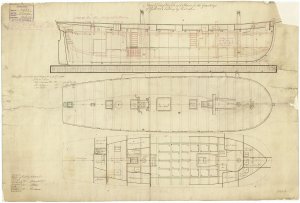
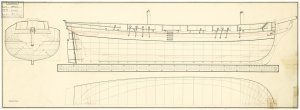


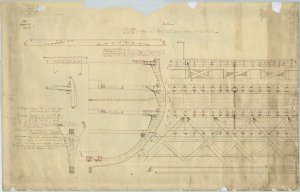
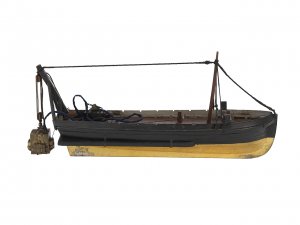
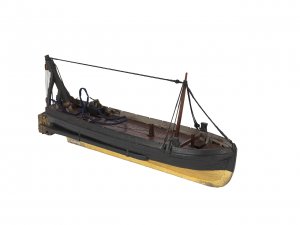

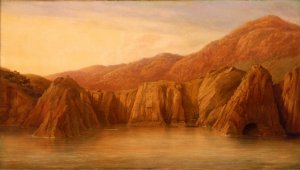
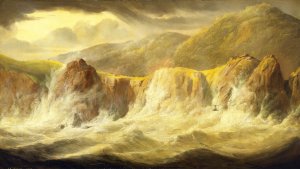
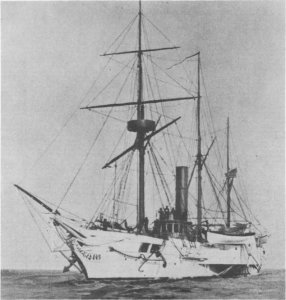
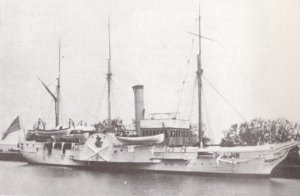
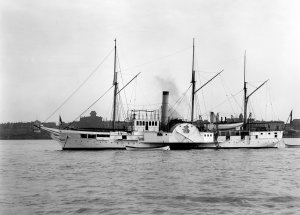
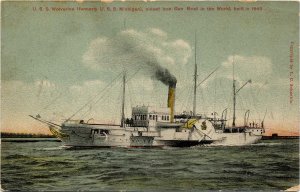
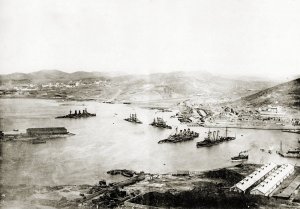
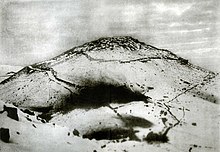

 of this defeat inflamed Japanese popular opinion against Nogi. General Yamagata urged his
of this defeat inflamed Japanese popular opinion against Nogi. General Yamagata urged his 